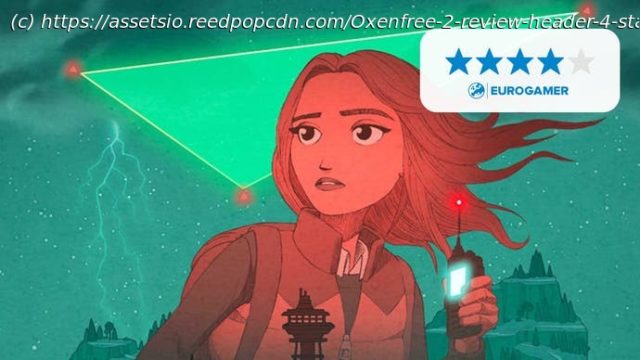Our review of Oxenfree 2: Lost Signals.
If I remember this correctly, the movie American Graffiti starts with a close-up of a car radio frequency display. American Graffiti is about a group of young people wandering around on a special night. George Lucas‘ next film would be the one to take us out to a galaxy far, far away, but, even back in the day, on a crackly fourteen-inch TV screen, that radio shot in American Graffiti looked absolutely gigantic. It’s just numbers and lines, and yet here was a panorama, lightyears wide, filled with deep mystery, somehow grown-up and somehow incomprehensible. Turn the dial. The needle scrolls, static twists into high notes and descends into a low fuzzy grumble before suddenly – implausibly – erupting into song.
Radio has always seemed the most shadowed and unlikely of technologies. Analogue radio: you dialed in, you tuned and tweaked and pretty much dowsed for what you were after. Where’s Radio 1 gotten to today? And there was all this little stuff in between the big stuff, the actual stations, that as a kid I found even more interesting. I can still reel off the numbers of certain stations – long after my mum has forgotten the names of her children she will still understand what 94.5 means – but I can also recall long bored nights turning the dial through the darkness and enjoying the backwash tidal sounds of the gaps between. The gaps! Dead air. Almost empty space. Nebulas spinning. Moon dust. Black bubbles turning on the surface of fresh coffee. All images conjured because the gaps were mere sound. I wish we still had technology like this, technology that was spatial yet invisible, the very opposite of user-friendly. Something that whistled and sparked. Something murky, spooky, irascible, and filled with all that cursed analogue potential.
The Oxenfree games are all about radios, and they’re also very good with the idea of gaps. The first Oxenfree dumped a bunch of kids on an abandoned island and saw them wandering and chatting and uncovering a supernatural mystery. It was a game about walking between points on the map and learning more about your companions through conversation choices. But it was also about that radio you carried, with a dial you could scroll through whenever you fancied, and which, in the right circumstances, could reveal a secret world and tear open holes in space and time.
But those gaps! It was in between the big events that Oxenfree really spoke, I think. It was in these gaps where you were headed somewhere or headed away from somewhere, where you suddenly realised something about one of the party members, or when you saw the balance of power shift in a relationship. Someone would reply to an off-hand comment with surprising honesty. Or someone would lie, and it would be obvious, and you would suddenly understand that you knew why they’d done that. Oxenfree’s radio had lovely staticky oceans between its haunted stations. And it had these spaces within its narrative where you could actually take a moment to make sense of everything, or simply ponder how much you did not know.
Oxenfree 2 has another radio, and it has more of those wonderful gaps. AM waves breaking on dark shores, absolutely, but also a moment where your walking companion Jacob will ask to play a game of one-word stories to calm him down, or when he will start narrating his own actions to allow himself a sense of control over the uncontrollable. How small, how domestic and true. And the sense, as you learn about one another, is that at any moment you could pull out the radio and find a hidden synchronicity between your precise location and a precise spot on the dial. What might the game do then?
What Oxenfree 2 does most of the time is what Oxenfree 1 did. There’s a new, slightly older cast – and it’s largely just a double-act now, just Jacob and Riley, the player character – and there’s the coastal town Camena, a new, larger location to explore. But Edwards Island from the first game is visible in the distance often, and the new cast are still uncertain and hesitant and navigating the barriers they’ve placed between themselves and the world in a way that feels very familiar.






